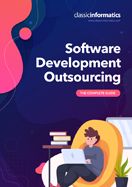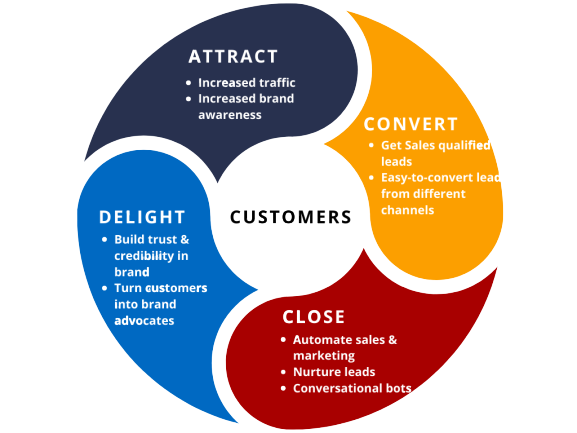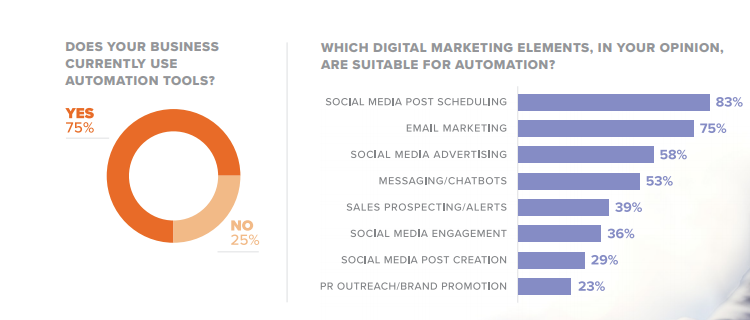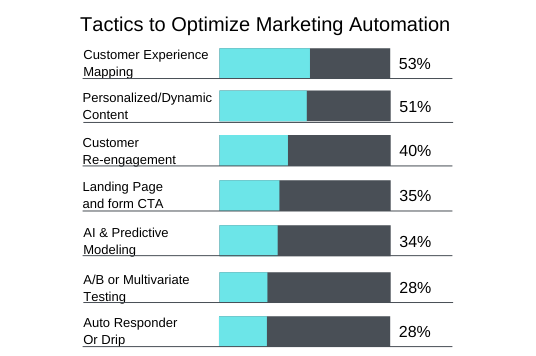Now that we know the factors you need to evaluate before making a decision on investing in marketing automation software, let’s see the list of top marketing automation software.
There are many marketing automation platforms in the market that are available for a number of uses. Let’s take a look at the three key players.
Marketo
This is one of the most popular marketing automation software in the market that is targeted at automating marketing and sales operations. It goes beyond the basic marketing and even has a marketplace called LaunchPoint that offers many integrations. You can find functionalities like:
- Lead Generation
- Email Marketing
- Campaign Management
- Budgeting Tool
- Visitor Tracking
- Personalized Messaging
The price for Marketo starts from $1,195 per month.
Hubspot
The brand that gave inbound marketing its name, Hubspot is indeed one of the most popular marketing automation tools out there. This tool offers everything that you can want from a marketing automation software and much more than that. Its all-in-one approach comes with functionalities like:
- CMS System
- Marketing Automation
- Lead Generation
- Real-time Analytics
- Salesforce Integration
- Free CRM
- Sales Hub
- Social Media Integration
The price for Hubspot starts from just $200 per month
Pardot
Another marketing automation software that has been dominating the market is Pardot. This tool is great for organizations that are looking to boost their sales. The tool is built in such a way that it pushes the leads further down the pipeline. The features and functionalities include:
- Lead Generation
- Lead Scoring
- Lead Nurturing
- Sales Alert & Reporting
- Social Media Integration
- ROI Reporting
The price for Pardot starts from $1,250 per month
Customer.io
A very interesting and interactive platform, Customer.io is known to be using data from customer interaction for creating bespoke email messaging. You can set up pre-determined rules for actions that could trigger a certain response. The features include:
- Comprehensive Segmentation
- Direct Integrations
- Workflow Automation
- Third-party Integrations
The price for Customer.io starts from $150 per month
There are many marketing automation tools available in the market today. However, the four discussed above are the top players. While you can choose from any of the above-mentioned marketing automation tools, there is a reason why most businesses opt for Hubspot when they need an all-rounder marketing automation tool for their business.
So, let’s take a quick look at why Hubspot is the ideal choice for marketing automation.
Why Hubspot?
There are so many marketing automation tools in the market. So, why should we still opt for Hubspot for automating our marketing tasks?
Many of the marketers, digital agencies, enterprises, and small or mid-size businesses have the same question. In this chapter, we will answer this question by discussing Hubspot in two parameters- how it is different from other marketing automation platforms and what are the benefits of using this platform
But before that, let’s understand what Hubspot actually is.
What is Hubspot?
Hubspot is a powerful marketing automation software that helps businesses make the most of their inbound marketing strategy. Called the ‘inbound marketing tool’ by Hubspot itself, this is one of the most popular tools for marketing automation. This tool can help you attract, convert, and delight customers at each stage of their buying lifecycle.
HubSpot’s workflow tool is automation beyond email, so you can scale your growth and spend less time on repetitive tasks.
When you aim to succeed in marketing with inbound, Hubspot marketing automation software is what you need. Hubspot’s marketing automation software is built in a way that it complements your inbound marketing strategy. With the Hubspot automation software, you get an upper hand in the market by targeting the customer sentiments.
It has a full-grown suite that comprises everything from marketing software, sales software, support software, and other integrating directly with Hubspot CRM.
How Is Hubspot Different From Other Marketing Tools?
Let’s come to an interesting topic and see how Hubspot is different from all the other marketing automation tools available in the market. You can find a plethora of factors that set Hubspot apart from other marketing tools. Here’s a quick gist:
Full-Growth Software
Unlike other marketing automation software, Hubspot doesn’t just offer a marketing automation software to tackle your marketing needs. It is a full growth suite which helps you integrate sales automation marketing automation, and support together with its free CRM tool. It enables all your teams (sales, marketing, operations, and even business owners) to focus on customers and work on turning in more leads.
Create Buyer Persona
While most marketing tools offer automation functionalities, Hubspot takes a step further by letting you target content based on buyer personas. It helps you create marketing strategies and campaigns that are based on your buyer personas. This way, you are not sending away the same message to all your customers. Instead, it is targeted to suit their personal interests and ensures increased engagement.
Define Lifecycle Stages
Not only does Hubspot allow you to create buyer personas, but you can also define the life cycle stages for each of the personas. This way, you can segment your marketing strategy even further. Not only will you be segmenting your target audience but also bifurcating them based on their stage in the buyer journey. So, the chances of delivering your customers what they actually want and engaging with them increase even further.
|
Factors
|
Hubspot
|
Marketo
|
Pardot
|
Customer.io
|
|
Content Creation
|
Website pages, Landing pages, Blogs, and all other forms of content
|
Landing pages, no blog management
|
Landing pages, only blog integration
|
Create landing pages
|
|
Forms & Pop-up Forms
|
Create both and customize them
|
No Pop-up forms
|
No Pop-up forms
|
No Pop-up forms
|
|
Live Chat
|
Add new Live Chat option and automated bots
|
Needs External integration
|
Needs External integration
|
Needs External integration
|
|
A/B Testing
|
Available for everything including blogs, emails, landing pages, CTAs, Forms, etc. Launched Adaptive Testing
|
Create A/B testing for email programs and landing pages
|
Offers Email Toggling for A/B testing on emails
|
Offers A/B testing for emails and email campaigns
|
|
List Management
|
Offers List Management support
|
Offers Smart List option
|
Can create and manage lists
|
No List Management
|
|
Social
|
Auto publishing feature and post scheduling, and bulk scheduling available
|
Offers social media integration
|
Offers social media scheduling with AddThis connectors
|
Not available
|
|
Pricing
|
Starts $50 per month
|
Starts $895 per month
|
Starts $1,000 per month
|
Starts $150 per month
|
Benefits Of Using Hubspot As a Marketing Tool
Now that we know how Hubspot marketing automation platform is different from other marketing automation platforms, let’s get into understanding the benefits that this can have.
Whether you are a business or an inbound marketing agency, there are many benefits that you can have with Hubspot. This all-in-one marketing hub can offer you integration with your software and even offers a CMS system, sales hub, service hub, and much more. So, let’s get into it.
Create And Publish Content Independently
Most of the marketing automation tools offer you the functionality to create blog posts or similar content, Hubspot is lined with better functionalities. As Hubspot offers a CMS hub with the marketing automation software, you can create blogs, website pages, and even landing pages using Hubspot.
Real-Time SEO Suggestions
Another aspect of the Hubspot marketing tool is that it offers you real-time SEO suggestions to optimize the content for better visibility on social media. It gives you suggestions for ideas you can add in your content, page title and its characters, meta description and subtopics, number of words, meta tags, links in the content, Alt Text in the images, and much more. This ensures that your content is SEO-friendly and can be displayed by the search engines in their SERP.
Content Strategy
Hubspot CMS offers you the functionality to create an all-in-one pillar page that is connected to all the blogs in the particular topic cluster. So, executing complex content strategies becomes easier with the Hubspot tool. This is very beneficial for your inbound marketing. As even if a single page is ranking in one topic cluster, all the other pages would also get the link juices and start ranking. Moreover, it also gives you a single place where you can find all the related blogs to interlink.
Campaign Creation
Another great feature present in the Hubspot marketing automation tool is the capability to create campaigns. You can create different campaigns for your marketing team, sales team, business development team, and others. You can set up goals for metrics like sessions (traffic to the website), new contacts, influenced contacts, closed deals, influenced revenue, and much more. You can also set up the budget for the campaign along with any notes you want to add. Hubspot would automatically create reports showcasing not just the goals but also the social posts, CTAs used for that campaign, the performance of website pages in that campaign, and much more. Overall, it makes it easier to track everything in a campaign to improve as per the analysis.
Social Media Scheduling
The next advantage of using Hubspot as your marketing automation tool is that it has social media integration. You can link Facebook, LinkedIn, Twitter, and Google+ to your Hubspot tool. Moreover, you can also turn on the social media auto-publishing option to automate social media posting. This means when you are publishing any new post on your blog page, it can fetch the meta description and publish it on your social media after 15 minutes of publishing. It also allows you the functionality to customize the content for posting on social media channels.
Complete Analytics
Just delivering content without any idea about the value it is driving is of no use. Measuring the success of any of your most is very important to improve the strategy and drive better results. With Hubspot marketing automation tool, you not only get reporting and analytics dashboards but also get the option to create new dashboards.
Project Management
No more hassle in managing your marketing projects now. With Hubspot, you get the functionality to assign tasks to your team members and keep a track of everything. You can create tasks, assign them, and set the due date. Apart from that, you can also create projects with goals and sub-tasks under them. This helps you keep a tab on everything that needs to be done without missing out on anything. The best part about Hubspot as a marketing automation software is that it comes with hundreds of pre-designed project templates for all your marketing goals like lead nurturing, social media, conversion rate optimization, lead generation, etc., created by Hubspot itself.
Lead Nurturing
Nurturing leads and pushing them further down the sales funnel is imperative for any marketing campaign. When you are taking the inbound way, it is even more important that you are able to nurture leads that are not yet ready to buy or make a purchase. Did you know that only 20% of leads are in the ‘ready-to-buy’ stage when they first engage with any brand?
Thus, a well-planned lead nurturing process is important to turn these remaining 80% leads into sales-qualified leads. With the Hubspot marketing automation tool, lead nurturing becomes easier. The workflows and the triggered responses based on customer actions and keep them engaged so that when they are ready to buy, yours is the first name that comes to their mind.
CRM Integration
Customer relationship management is at the top of any business’s marketing strategy. Hubspot offers free CRM integration ‘With Something For Everyone’. This offers you a real-time update on the entire sales pipeline presented on a clean visual dashboard. It automatically creates reports for your entire sales and marketing efforts. Also, you get company insights, deals tracking, pipeline management, email tracking, meeting scheduling, live chat, and much more.
Email Marketing (Triggered Emails In Real-Time)
Most of the companies have an automated email system that automatically sends a pre-generated email. With Hubspot, you can create workflows that automate the email response process. You can create email templates for each stage of the buying journey for each buyer persona. And Hubspot does the rest.
It automatically sends emails personalized according to the name and other things. You can create emails to be sent after getting triggered on certain actions.
Powerful Form Builder
Another feature of Hubspot is the form-builder that you get. Creating new forms is very important for any inbound marketing campaign to collect their data. Hubspot allows you to create both on-page forms and pop-up forms. No other marketing automation software has the feature to build pop-up forms. Integrating these forms on your pages is also very easy and you can even run the same form on different pages with just a simple step of adding the pages’ links.
You can personalize the forms, add images, create new fields, customize the content, link to different pages, etc., with the powerful form builder that Hubspot offers.
Live Chat
Inbound marketing means delighting your customers at each stage of the journey to finally convert them into active buyers. And a live chat option is important for that. With Hubspot, you can create a live chat functionality on your website. The best part is that Hubspot analyzes the intent of the visitor and directs them to the right member of your team. If a person is in the decision stage, the visitor would be directed to the Business Development person. If a person is still in the awareness stage, he/she would be directed to the other department.
A/B Testing
Having the A/B testing feature is important to ensure that your website works seamlessly. Most of the marketing automation platforms in the market have a limit to the A/B testing feature like it could be limited to the landing pages or website pages. With Hubspot, you get A/B testing for everything including emails, forms, CTAs, blogs, landing pages, and all other things. You can easily switch between the two variations. This can help you know which variation is liked by your target audience and which version would work.
‘How To’ Of Hubspot Marketing Automation
We know that when it comes to inbound marketing, there is no better automation tool than Hubspot. This was the platform that introduced the concept of inbound and has all the functionalities required to succeed with inbound marketing.
However, just buying the Hubspot marketing automation won’t take you far with inbound marketing. Whether you are a novice or have been using a marketing automation tool for long, the following pieces would definitely help you become better with Hubspot marketing automation and succeed with inbound marketing.
Workflow Creation
Creating workflows is extremely important yet very simple with Hubspot. These workflows can be used for multiple things like lead nurturing, automatic follow-ups, classifying leads internally, and much more. You can start with the following steps:
-
Select the workflow type by navigating to Automation and Workflows under it. Here you can Create Workflow.
-
You can create a workflow to Start from Scratch or choose from the Templates available. You can choose the type of workflow you want to create.
-
Now you can create Enrollment Triggers to set into action a series of responses based on the user triggers. Here, you can choose to trigger the particular workflow based on the contact properties, page views, list membership, call-to-actions, and much more.
-
You can also add actions in the workflow by clicking on the Plus + Icon.
Set-up Campaigns
Any marketing personnel would know how important it is to create a well-planned and researched marketing campaign. Here are the steps you can follow to create and set-up a campaign in Hubspot.
-
Under the Marketing head, go to Planning & Strategy and select Campaigns to create one.
-
You can click on Create Campaigns on the right to start.
-
Next, add in the Budget, Goals, Assets (blogs, emails, landing pages, etc.,) that would be a part of that particular campaign.
-
You can also Create a Tracking URL under the Actions button once the campaign is created. The page should have a Hubspot tracking code and you can easily create the tracking URL to analyze the campaign performance.
Create Blogs & Landing Pages
As a marketing automation software, Hubspot’s main functionality is the ease of creating both blog pages, website pages, and landing pages. Let’s have a quick look at the steps to creating blogs and landing pages in Hubspot.
-
Under the Marketing tab, go to Website and choose from Website Pages, Landing Pages, or Blogs.
-
You can select Create on the upper right and choose the Template you want to choose for the landing page or the website page.
-
To create a blog post, you can select from the different templates you have and choose in-line edit or draft mode to start writing.
Automate Chat
If you are planning to automate your chat flow, Hubspot is the way to go. It is very effective in chat and automation and even helps you create bots for your business that can interact with your audience in case your teams are away. To create the same, you can follow the below-given steps:
-
Go to Conversations and Chatflows under it.
-
You can Create Chatflows by clicking on the button on the right. Choose the Build a bot section and select the bot template.
-
You can enter the Welcome message and add any other Question by clicking on the Plus icon.
-
You can also route the conversation to any member of your team to handle the conversation further.
-
Automating the chats and targeting the messages through the chatbots is also simple with Hubspot.
-
You can select query parameters in the bots and select targeting rules. You can also Add an Exclusion rule.
-
You can also segment the targeting of the bot to specific audiences under the Visitor Information section. You can select different actions from the drop-downs. You can select from Contacts or all visitors based on the CTA clicked, device type, SEO topic, pages visited, and much more.
Capture Leads
Another benefit of using Hubspot for marketing automation is the functionality to create and roll-out automated CTA or forms for different pages for capturing leads.
-
You can easily create Image CTA, button CTA, text with a link, etc. Under Marketing, go to Lead Capture and select CTA for that. You can create a new CTA from the button on the right. The best part, you can use the same CTA on more than one page with the same intent.
-
You can create forms by selecting Forms under Lead Capture in Marketing.
-
Hubspot offers the functionality to create simple web forms as well as pop-up forms for different pages to capture leads.
-
It is even possible to share your Hubspot page on any non-Hubspot website if you have a business running on a non-Hubspot CMS.
Social Media
Another great automation feature of Hubspot is that it allows social media integration and even automates social scheduling after blog publishing. Here are some ways to do that:
-
You can create social posts by selecting Social under the Marketing tab. Here you can Create any new social post for any of your channels by adding the link and writing the social media content.
-
You can schedule social media for your blog posts in bulk as well by selecting Schedule In Bulk. Add the links, content, and other things in the Excel sheet in the same format as offered by Hubspot and upload the sheet.
-
Hubspot offers the auto-publishing option for all the new blog posts that you publish on your website. Once turned on, this option automates the social media sharing of new posts. All posts would be automatically shared on social media after 15 minutes of the post going live. You can also change the content or it would automatically take the meta description of the blog.
-
Hubspot also offers Hubspot extension for chrome for social media posting. No matter what page you are on, whether it is your website’s page or any external site, you can use this integration tool to instantly schedule any post on your social media channels.
If you are using the Hubspot marketing automation tool for your inbound marketing, this platform offers a complete and extensive knowledge base for you. You can check the Hubspot Help Center here to find quick answers to all your questions.
Conclusion
We know that the marketing ecosystem is changing. But, inbound marketing strategies are here to stay. Today’s buyers have become smarter and are looking for brands that can offer them value throughout their buying journey. You can become the brand that buyers love with inbound marketing.
Indeed, inbound marketing is the way to go when you want to generate more traffic through content. However, keeping a track of the traffic that comprises buyers, sales-qualified leads, not-ready-to-buy leads, etc., isn’t easy.
This can be done using a marketing automation tool. Fueling your inbound strategy with marketing automation software can help you manage the leads, maximize sales opportunities, and delight them to become your brand advocates.
And we couldn’t have talked about inbound marketing and marketing automation without mentioning Hubspot. This is one of the most powerful marketing platforms that allow you to streamline your inbound marketing efforts and turn the traffic into leads. Hubspot not only supports the inbound methodology, but it also helps you ace it. You stay in touch with the buyer at each stage of the sales cycle.
At Classic Informatics, we selected Hubspot as our inbound marketing tool. It allows us to bring together our marketing and sales teams to close more deals. We are a certified Hubspot Solutions Partner offering expert inbound marketing services. We can help you onboard the marketing automation platform and get started with Hubspot.
Do you want to-
Increase brand awareness?
Target the right audience with your content?
Boost your online conversions?
Or increase your inbound sales?
Classic Informatics is the organization that can help you achieve these vital inbound outcomes with its inbound marketing services. With our services, you get the dream team comprising expert marketers, inbound strategists, designers and developers, and content creators. And it doesn’t stop there.
We also help you with Hubspot implementation if you are looking to automate your marketing with Hubspot. From onboarding, implementation, website creation, optimization, and Hubspot migration to sales and marketing automation, we do it all for you.

 Healthcare 360 HealthTech
Healthcare 360 HealthTech Digital Economy New tech solutions
Digital Economy New tech solutions SaaS Development Modern SaaS solutions
SaaS Development Modern SaaS solutions Government Software E-Governance solutions
Government Software E-Governance solutions FinTech Automate financial system
FinTech Automate financial system Logistics Efficient operations
Logistics Efficient operations Retail E-stores Powerful online stores
Retail E-stores Powerful online stores Travel Simplified portals
Travel Simplified portals





















